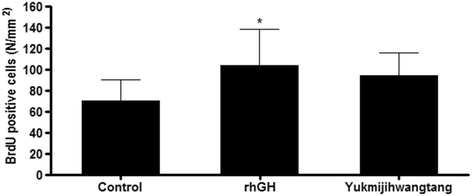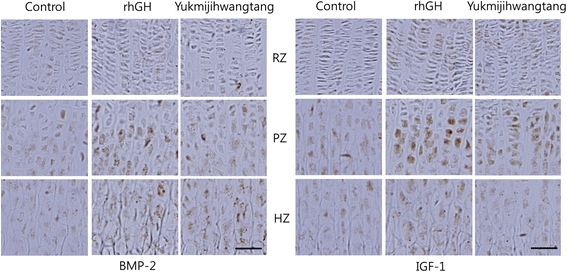The Korean herbal formulation Yukmijihwangtang stimulates longitudinal bone growth in animal models
- PMID: 28464905
- PMCID: PMC5414215
- DOI: 10.1186/s12906-017-1651-1
The Korean herbal formulation Yukmijihwangtang stimulates longitudinal bone growth in animal models
Abstract
Background: Yukmijihwangtang (YJT) is a traditional Korean medicine that has been used to treat kidney-yin deficiency symptoms such as dizziness and tinnitus. In addition, because it is also thought to nourish kidney-yin, it has been used to treat short stature from congenital deficiency. This study evaluated the effects of YJT on longitudinal bone growth in rats.
Methods: Female adolescent rats were randomly assigned to groups that received distilled water (per os [p.o.] twice a day; control), recombinant human growth hormone (rhGH; 20 μg/kg, subcutaneous [s.c.] once a day), or two different doses of YJT (100 or 300 mg/kg, p.o. twice a day). In each group, treatment was maintained for 4 days. Rats were injected intraperitoneally with 5-bromo-2'-deoxyuridine (BrdU; 50 mg/kg) to label proliferating chondrocytes on days 2 - 4. Tetracycline hydrochloride (20 mg/kg) was injected intraperitoneally to form fluorescent bands on the growth plates on day 3 for measuring the longitudinal bone growth rate. Expression of insulin-like growth factor-1 (IGF-1) and bone morphogenetic protein-2 (BMP-2) in the growth plate was identified using immunohistochemistry.
Results: There was a significant increase in the rate of bone growth in the 300 mg/kg YJT group (523.8 ± 23.7 μm/day; P < 0.05) compared to the control group (498.0 ± 23.8 μm/day), while the 100 mg/kg YJT group exhibited a non-significant increase. The number of BrdU-positive cells in the chondrocytes of the rhGH-treated group exhibited a significant increase (103.8 ± 34.2 cells/mm2) compared to that of the control group (70.3 ± 19.7 cells/mm2), while the 300 mg/kg YJT group had a non-significant increase. Additionally, IGF-1 and BMP-2 were highly expressed in the growth plate in the 300 mg/kg YJT and rhGH groups.
Conclusions: YJT increased the longitudinal bone growth rate by stimulating chondrocyte proliferation with increasing increments of local IGF-1 and BMP-2 expression. Based on these findings, YJT may be a therapeutic candidate for the treatment of growth retardation during adolescence.
Keywords: Growth plate; Longitudinal bone growth; Recombinant human growth hormone; Yukmijihwangtang.
Figures






Similar articles
-
The herbal formula HT042 induces longitudinal bone growth in adolescent female rats.J Med Food. 2010 Dec;13(6):1376-84. doi: 10.1089/jmf.2010.1007. J Med Food. 2010. PMID: 21091251
-
Effects of Siwu decoction on chondrocyte proliferation of growth plate in adolescent rats.J Ethnopharmacol. 2019 May 23;236:108-113. doi: 10.1016/j.jep.2019.01.048. Epub 2019 Mar 5. J Ethnopharmacol. 2019. PMID: 30849503
-
Effects of Eucommia ulmoides extract on longitudinal bone growth rate in adolescent female rats.Phytother Res. 2015 Jan;29(1):148-53. doi: 10.1002/ptr.5195. Epub 2014 Aug 2. Phytother Res. 2015. PMID: 25087723
-
Effects of chemotherapy on bone metabolism and skeletal growth.Horm Res. 2002;58 Suppl 1:80-5. doi: 10.1159/000064769. Horm Res. 2002. PMID: 12373019 Review.
-
Inflammation and linear bone growth: the inhibitory role of SOCS2 on GH/IGF-1 signaling.Pediatr Nephrol. 2013 Apr;28(4):547-56. doi: 10.1007/s00467-012-2271-0. Epub 2012 Aug 11. Pediatr Nephrol. 2013. PMID: 22886280 Review.
Cited by
-
The Effects of Natural Product-Derived Extracts for Longitudinal Bone Growth: An Overview of In Vivo Experiments.Int J Mol Sci. 2023 Nov 22;24(23):16608. doi: 10.3390/ijms242316608. Int J Mol Sci. 2023. PMID: 38068932 Free PMC article. Review.
-
Effectiveness and Safety of Combination Therapy with Herbal Medicine and Growth Hormone Compared to Growth Hormone Monotherapy for Short Stature Children: A Systematic Review and Meta-Analysis.Evid Based Complement Alternat Med. 2022 Aug 9;2022:5725258. doi: 10.1155/2022/5725258. eCollection 2022. Evid Based Complement Alternat Med. 2022. PMID: 35982997 Free PMC article. Review.
-
A Mixture of Humulus japonicus Increases Longitudinal Bone Growth Rate in Sprague Dawley Rats.Nutrients. 2020 Aug 28;12(9):2625. doi: 10.3390/nu12092625. Nutrients. 2020. PMID: 32872370 Free PMC article.
-
Effects of Eleutherococcus Extract Mixture on Endochondral Bone Formation in Rats.Int J Mol Sci. 2019 Mar 12;20(5):1253. doi: 10.3390/ijms20051253. Int J Mol Sci. 2019. PMID: 30871109 Free PMC article.
-
Yukmijihwang-Tang Suppresses Receptor Activator of Nuclear Factor Kappa-B Ligand (RANKL)-Induced Osteoclast Differentiation and Prevents Ovariectomy (OVX)-Mediated Bone Loss.Molecules. 2021 Dec 14;26(24):7579. doi: 10.3390/molecules26247579. Molecules. 2021. PMID: 34946658 Free PMC article.
References
-
- Yuhong H, Qian L, Yu L, Yingqiang Z, Yanfen L, Shujing Y, Shufang Q, Lanjun S, Shuxuan Z, Baohe W. An n-of-1 trial service in clinical practice: testing the effectiveness of liuwei dihuang decoction for kidney-Yin deficiency syndrome. Evid Based Complement Alternat Med. 2013;2013:827915. doi: 10.1155/2013/827915. - DOI - PMC - PubMed
-
- Huang Y, Zhang H, Yang S, Qiao H, Zhou W, Zhang Y. Liuwei Dihuang decoction facilitates the induction of long-term potentiation (LTP) in senescence accelerated mouse/prone 8 (SAMP8) hippocampal slices by inhibiting voltage-dependent calcium channels (VDCCs) and promoting N-methyl-d-aspartate receptor (NMDA) receptors. J Ethnopharmacol. 2012;140(2):384–390. doi: 10.1016/j.jep.2012.01.030. - DOI - PubMed
MeSH terms
Substances
LinkOut - more resources
Full Text Sources
Other Literature Sources
Miscellaneous

